No one likes cold feet. To keep my feet warm I use a variety of socks depending on the weather conditions. Recently the retailer I used for wool socks dropped the ones I liked and so the search for new options began. Here are a few options that I think work well:
- The REI Merino Wool Expedition Crew socks, the
- Wigwam Merino Woodland socks, and the
- J.B. Fields Icelandic socks.
All are good, but my main preferences are the REI Merino wool liner and either the Wigwam Merino Woodland socks or the –40ºC Islandic socks from Canada depending on expected temperatures.
I do not use hand warmers or any type of heating system that relies on batteries. I think these methods are unnecessary and unreliable. I want a system that is long lasting and dependable.
The 2-Sock Strategy
I use a 2-sock method. I use this method even on some summer trips. This method increases comfort and warmth and reduces the chances of blisters. It consist of a thin liner sock covered with a thick outer cushioning sock. Together, both need to allow the foot to flex and wiggle in the boot.
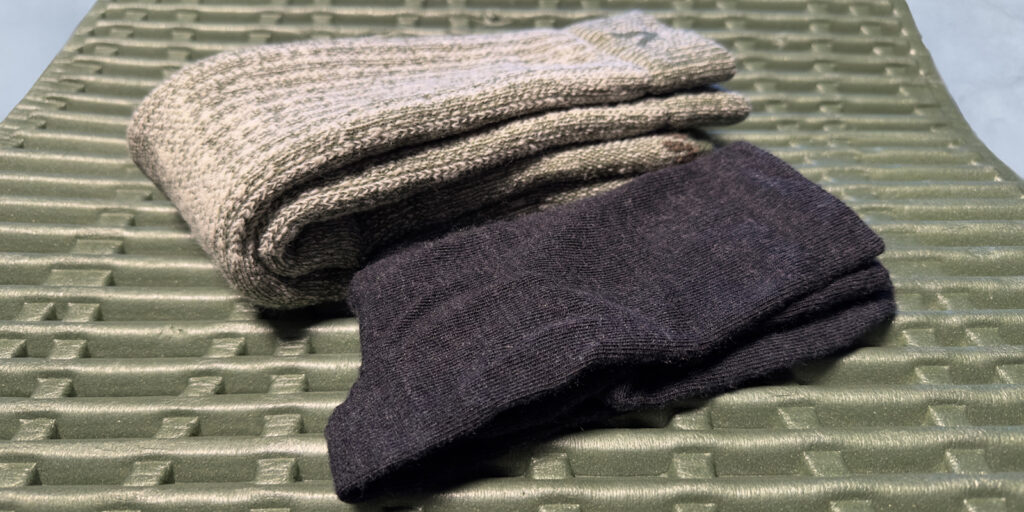
2-Sock Method Helps Prevent Blisters
Military studies have shown that wearing a thick wool outer sock over a liner sock resulted in the least blisters. “Foot blister incidence was lower among participants who wore the prototype boot sock and liner than among those wearing the standard military sock (40 vs. 69%, p < 0.001) or among subjects wearing the standard military sock with liner (40 vs. 77%, p < 0.001).” And foot “blisters and cellulitis severe enough to require medical attention occurred with greater frequency in the standard military sock group…” (https://pubmed.ncbi.nlm.nih.gov/8918120/). The double-sock strategy is effective for both warmth and blister prevention. For more about blister prevention and care, see Blisters: A Guide to Prevention and Treatment
For the best results, the fit, thickness, and materials of the socks has to align with the season conditions and what I call the basic Four Rules of Foot Warmth.
The Four Rules of Foot Warmth
- Circulation: Keeping your core warm and blood flow to your feet unrestricted is essential to warm feet. Blood flow provides warmth and tight socks and/or boots will restrict the blood flow and make your feet cold. When your body gets cold it naturally restricts blood flow to the feet and hands to preserve core temperature and save the heart making it essential to also keep your core warm. On a long hike your feet will swell making boots tighter too. To maintain blood circulation to the feet, you need boots that are 1–2 sizes larger than usual for winter use.
- Insulation: Natural fibers such as wool and alpaca make effective antimicrobial insulation, and more effective than synthetic alternatives such as Capilene. The cushion of thick socks provides loft that captures warmth. However, boot size must be adjusted up to allow thicker socks from constricting blood flow to the feet. Don’t allow the thickness of the socks to defeat rule number one. It ids possible to get winter socks that are too thick for your boots.
- Moisture: Moisture wicks warmth away from the skin making it important to keep the feet dry from both snow melt and sweat. If socks get wets it is important to be able to replace them with fresh socks because it is unlikely you will be able to dry socks and boots quickly in winter conditions. If socks are too warm or boots too waterproof the feet will become sweaty and the moisture will make the feet cold. The best strategy is to have an additional pair of outer socks for use around camp and for sleeping in at night. Maintain the waterproofing on your boots.
- Conduction: Foot warmth is lost through conduction to the cold ground. This is mainly a problem when standing on cold surfaces around camp. The thickness of the boot outsoles, midsoles, insoles, and sock layers can help reduce the transfer of warm. Warmer wool or alpaca insoles can be used only if they don’t make the boots too tight. The most practical and effective method is to use a folded solid-core pad (4 R-value when folded) under your boots while standing and sitting on ice or snow. You should, of course, use the folded pad under any part of your body that is on the snow while you are outside your tent.
Liner socks
I use two types of thin liner socks. For cold events the Merino Wool liners and for warmer events, the polyester ones.
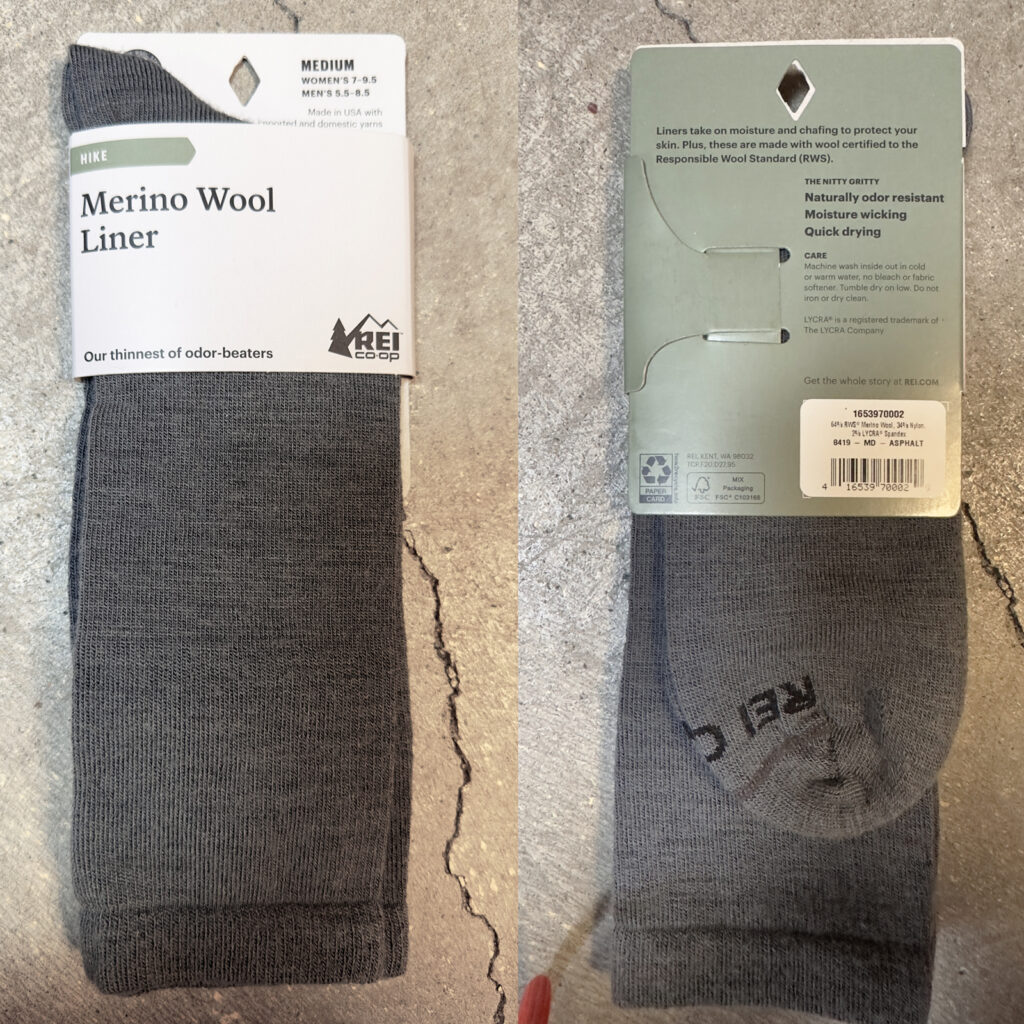
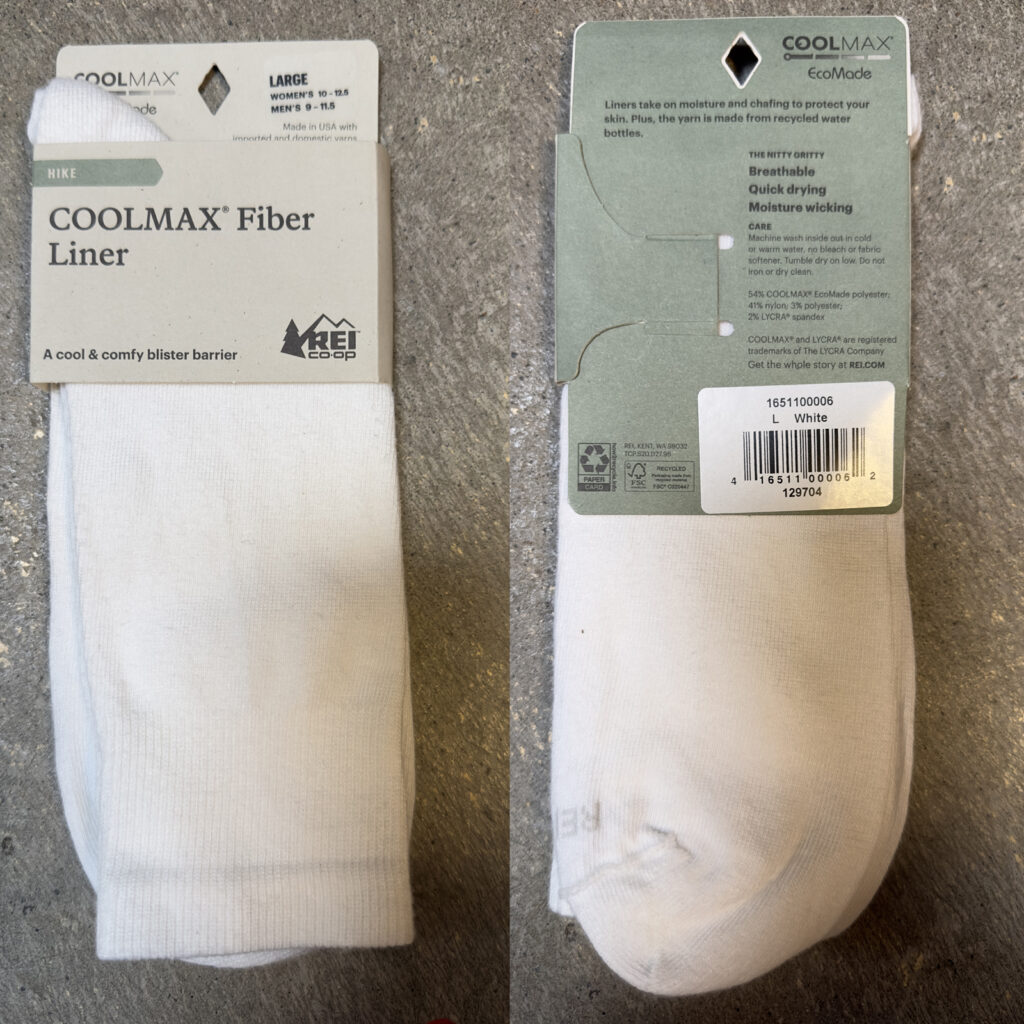
Pretty much any synthetic sock will work okay as a liner sock. Just be sure to avoid socks that contain cotton because cotton holds moisture to your skin and stays wet longer than synthetic materials.
Outer socks
Selecting outer wool socks is more difficult. There are many options on the market but most are too tight to slip comfortably over liner socks. My first recommendations are the Wigwam Merino Woodland and the REI Merino Wool Expedition Crew socks. These are fairly easy to find.
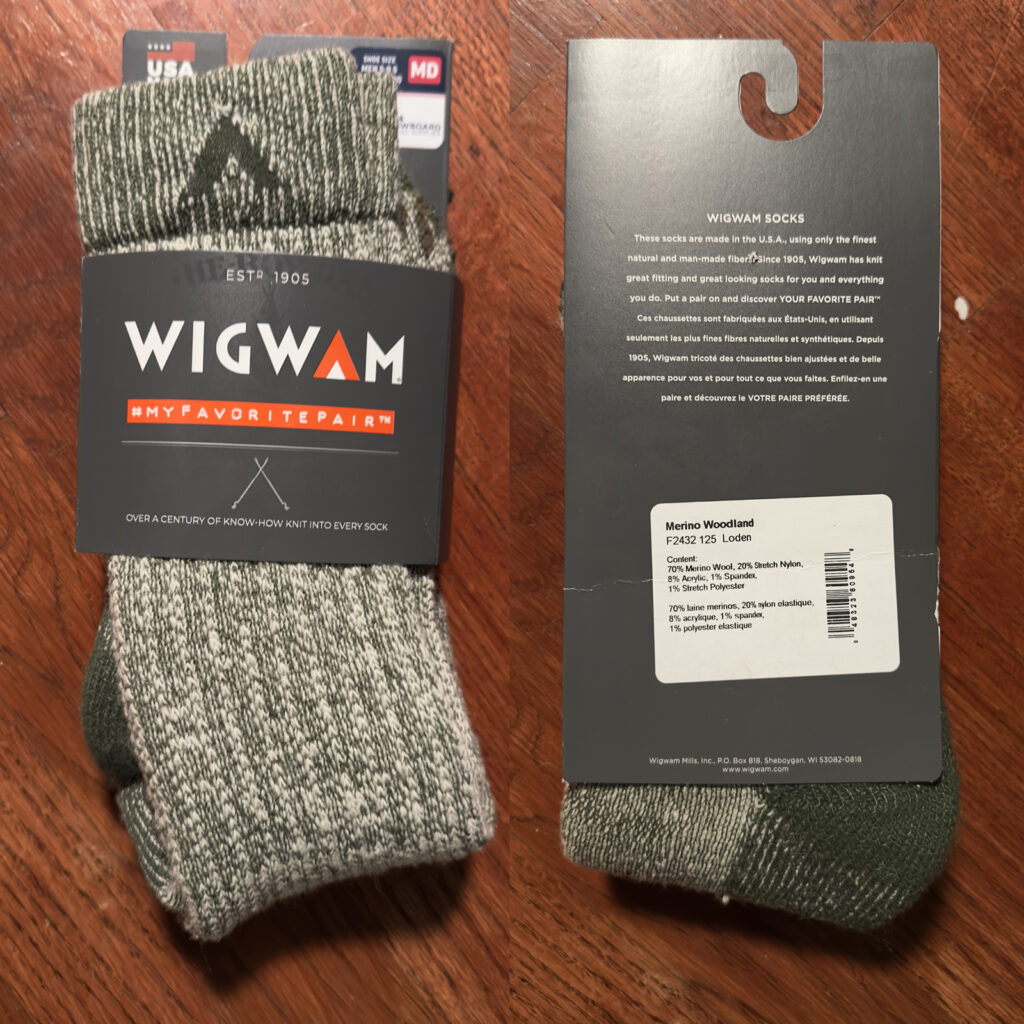
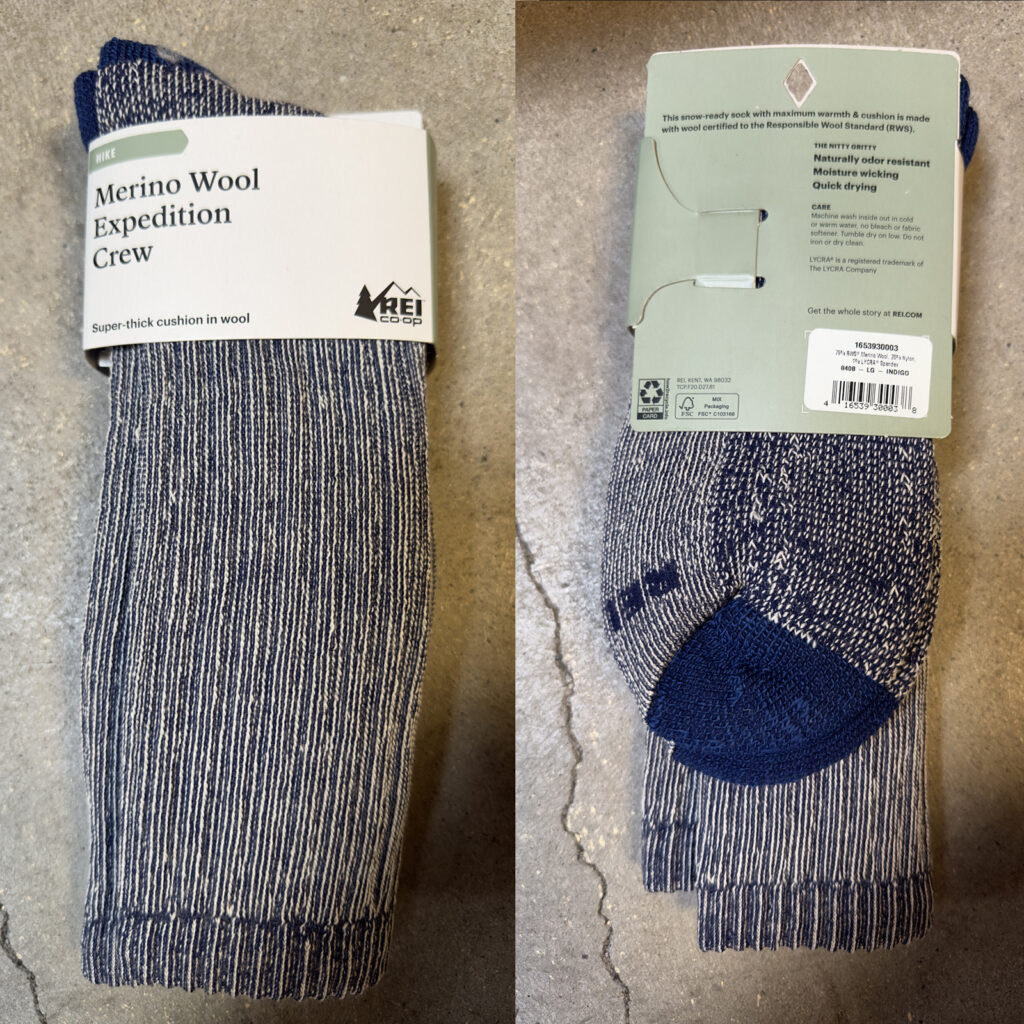
The Wigwam Merino Woodland work well for me. Wigwam is the supplier for the US olympic Ski and Snowboard team.
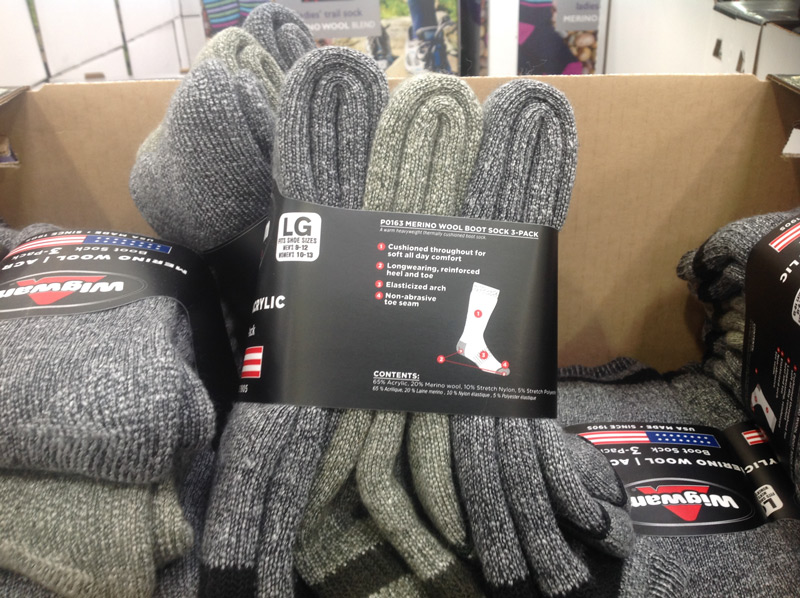
The Importance of Individual Fit
What works well for one person may not work well for another. It depends on your foot size. For example, many hikers are satisfied with Darn Tough socks but other find them too tight for winter use. You will not know what works for you until you try them on.
Once you have selected a comfortable fitting liner and out sock you must then select boots that fit comfortably over these layers. Ideally, even when wearing both layers of socks the boot should fit slightly loosely. This will ensure that your feet are warm in cold conditions.
Recently, I tried on four pairs of socks made by the Canadian company J.B. Fields. These were their “Icelandic” –30º, –35º, –40º, and –50º C socks. This photo shows the fit as I experienced it.
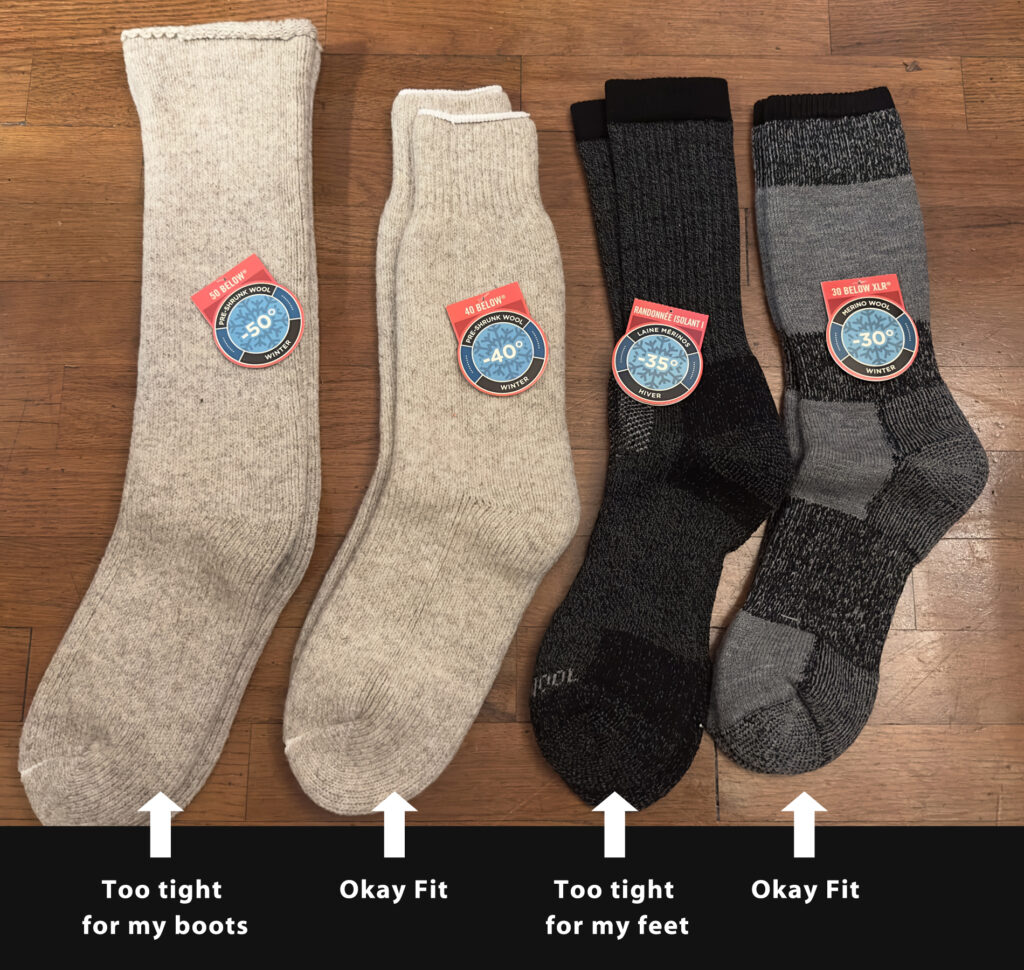
My boots were already upsized for my older two-sock system. The minus 50º were too thick for my boots. I would need to purchase another pair of boots to make them work and I’m pretty sure the socks would be too warm anyway for the PNW. However, if you are using lighter socks and still experiencing cold feet, this might be the better option for you. It’s a balance between getting socks that are warm around camp but not so warm your feet sweat too much while hiking.
The –40º pair fit okay. The –35 were too tight. The –30 were okay too. So depending on temps, I’ll use the –30º and –40º socks along with the Wigwam Woodland socks. I would love to have the –50º for use just around camp, but I don’t want to carry socks that I can’t also use hiking with my existing boot size. This is just my impression of the J.B. Fields “Icelandic” socks. Your experience may be different.
Weight
Weight is, of course, a concern too. Rather than carry the warmest and heaviest socks for all my winter trips, I want to take what is necessary to stay comfortable for the expected temperature range.
- REI Merino Wool Liner: 1.40 oz.
- Wigwam Woodland socks: 4.15 oz.
- Icelandic –30º C socks: 4.15 oz.
- Icelandic –40º C socks: 4.85 oz.
Typically, I am carrying one extra pair of outer socks to use around camp and in my sleeping bag. Each day I re-use the same liner and out sock that I hiked in before. To dry wet socks, you can lay them on your chest at night inside your sleeping bag. This will usually work provided they are not too wet.
What sock works for you?
I’ve described the system that works for me, adjusting for different temperatures, but there are a lot of sock options and more challenging winter conditions than the Pacific Northwest. Maybe you use no-show or double layered socks. In the comment section below, let us know what you are using, how successful it is keeping your feet warm, and in what conditions. Your comments and questions are welcomed.
I receive no monetary benefit for recommending any sock brand or type of sock.
6 replies on “What are the Best Socks for Winter Backpacking?”
My socks are Injinji liner toe socks with Meister neoprene toe warmers and SmartWool Mountaineer socks.
Oversized Vasque SnowBurban insulated boots.
This sounds good. I know a person who also likes the Injinji liner toe socks. What sort of conditions are you using them in?
Pretty much for all winter snowshoeing.
Mittens are warmer than full-finger gloves. Do you suppose that in the same way, regular socks might be warmer than Injinji socks? One way to find out would be to wear a Injinji on one foot and a regular liner sock on the other. I tried that with Merino wool and fleece for liner gloves. I was surprised to find that the fleece felt much warmer.
Thank you soooo much for this information! The information in this article has been a LIFESAVER!!!!!
I have a neurological condition where my feet tell my brain that they are constantly cold/freezing when they aren’t or not as bad as it seems. I’ve been tested and the Drs. aren’t sure what it is.
I live in SC and in the hot summer I have to wear Smartwool woolish running socks to keep my feet warm! I use to wear thicker Smartwool socks in the summer to keep my feet warm, but couldn’t stand the embarrassment of wearing ugly, thick winter socks in the hot SC summer! If I could wear winter boots in the summer I would.
I’ve been wearing all different levels of Smartwool socks during the winter with winter boots to keep my feet warm for years and I live in the South! Still couldn’t 100% kick the feeling of coldness in my feet all of the time. I’ve tried the heated socks, but they are annoying, not great with boots and i’m worried I’ll have it on to high and I won’t know it because my feet don’t send correct signals to my brain. Same with the feet warmers. Of course I may end up using the feet warmers when I’m in the snow, but they are not stainable for everyday, all day use.
Anyways, I’ll be taking my daughter skiing and playing in the snow up North soon and I have been REALLY nervous about my feet feeling like they are FREEZING. I use to own MUCK chore boots and just bought some really warm boots, but that’s half the battle. I’ve been doing tons of research and reviews etc. on socks to see if I’ve missed something or better socks on the market or new technology etc. and came across your article. I decided to give your suggestions a go. Went to REI and bought a pair of liners cause I’ve never tried it when I wear my Smartwool socks. I even talked to one of the REI employees who use to work for Smartwool and said the liners WOULD NOT make a difference with keeping my feet warm! He explained the sock liners are for the purpose to keep away blisters and I should try compression socks instead. I felt so defeated, but decided to try the liners and the compression socks. The compression socks didn’t really do anything (maybe it’s because I only tried one type? But it was ranked the best type on different reviews.) Tried the REI liners you suggested for the cold with different levels of Smartwool socks and it’s a GAME CHANGER!!!!! Will be trying your other recommendations for the outer socks! THANK YOU AGAIN!!!!
Hi Megan
Thanks for the comment. Perhaps you have Raynaud’s phenomenon. It is a condition that restricts blood flow to the extremities in response to cold temperatures. The double-sock method, as I understand it, works mainly because it allows hikers to wear loose boots without increasing the risk of blisters (heel slipping). It mainly adds warmth by allowing more circulation of blood to the feet. That is, to work well, it require up-sizing your boots. Because the boots extend up the ankle more than shoes, you can lace them to keep them from coming off. Compression socks are counter productive in cold weather. Adding an additional sock layer to already tight boots would also be counter production—it would actually make the feet colder because the feet would be more restricted. That said, an extra layer in itself will add some warmth if the boot is loose enough. For the thick outer sock, I prefer the wool Wigwam socks because they are warm and not too tight for the boots I’m using. I hope your feet are warm on your next ski trip.